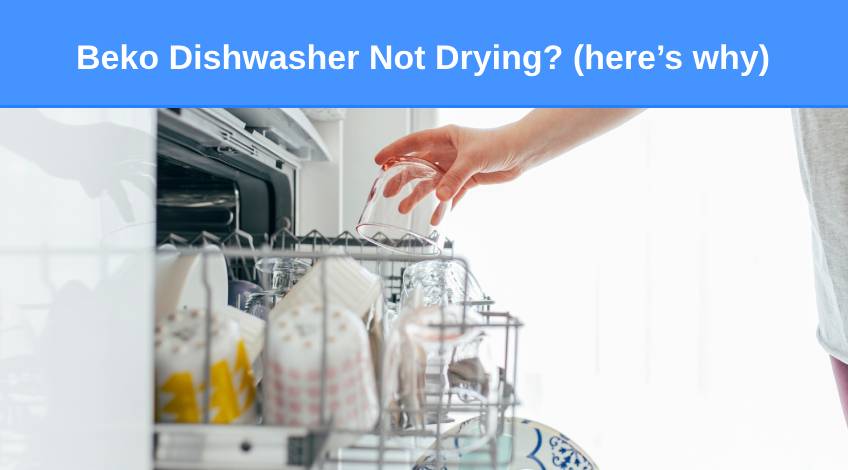
Beko Dishwasher Not Drying? (here’s why)
Owning a dishwasher eases the workload in the kitchen. There’s no need to wash and dry dirty dishes. All you need to do is load them in the dishwasher, press start and forget about it.
Once the cycle has finished the dishes are all clean and dry and ready to be packed away. Which makes it so much more of a problem if the dishwasher fails to dry the dishes.
If you own a Beko dishwasher and it has failed to dry your dishes, keep reading. In this article we take a close look at the reasons why your Beko dishwasher has not dried your dishes and offer solutions to this annoying issue.
Why Is My Beko Dishwasher Not Drying?
There are several reasons why your Beko dishwasher isn’t drying your dishes which include;
| Probable Cause | Solution |
|---|---|
| Loading The Dishes Incorrectly | Always ensure dishes are loaded correctly into the racks |
| Unloading Dishes Incorrectly | Always unload the lower rack first |
| Drying Plastic Dishes | Wash plastic dishes separately |
| No Rinse Aid | Ensure the rinse aid dispenser is topped up |
| Using Too Much Or An Incorrect Detergent | Ensure that you use the correct amount and type of detergent |
| Not Opening The Dishwasher Door | At the end of the cycle, open the door to allow hot, moist air to escape |
| Defective Thermostat | Check and replace the thermostat if necessary |
| Defective Heating Element | Check and replace the heating element if necessary |
| Faulty Aquaflex Function | Check that the Aquaflex function is working properly |
| Control Board Malfunction | Reset the appliance. Contact a technician |
Let’s take a closer look at each of these issues;
Loading The Dishes Incorrectly
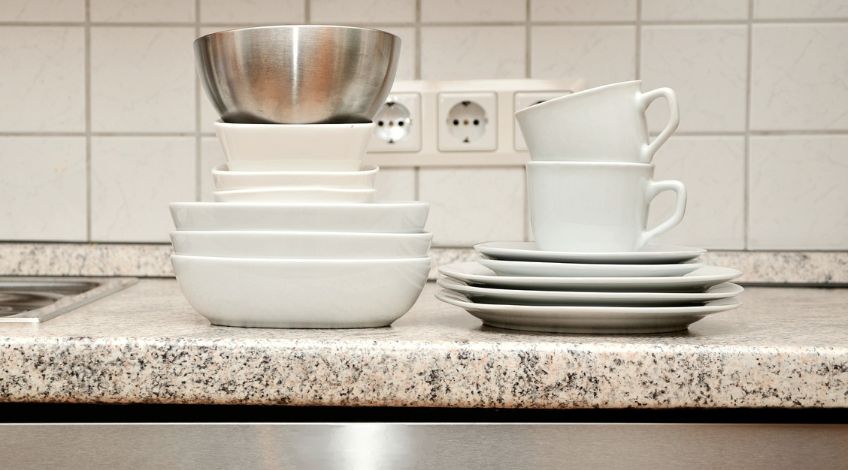
This is one of the most common reasons why dishwashers fail to dry dishes. It can be tempting to cram as many plates etc as possible into the dishwasher and get it all done in one go.
However, overloading the racks can lead to items overlapping each other which prevents them from getting washed and dried properly. You should ensure there is enough space between each item to allow adequate air flow to get each item dry.
The dishwasher should be loaded in the following way;
Upper Rack
Cups, bowls and glassware should be placed upside down on the upper rack to encourage proper cleaning and drying. Large utensils like spatulas should also be laid flat on the upper rack ensuring they cannot inhibit the detergent dispenser or prevent the door from closing properly.
Lower Rack
Plates should be placed one per slot facing inwards on the lower rack ensuring there is enough space between each one. Cookware like saucepans can also be placed upside down on the lower rack, ensuring that the handles don’t protrude and prevent the door from closing properly or inhibit the free movement of the spray arms.
Cutlery Rack
Knives, forks and spoons should be placed in the cutlery rack one piece per each compartment. They should be loaded alternately to avoid nesting and they should stand up straight and not be sloping.
Unloading Dishes Incorrectly
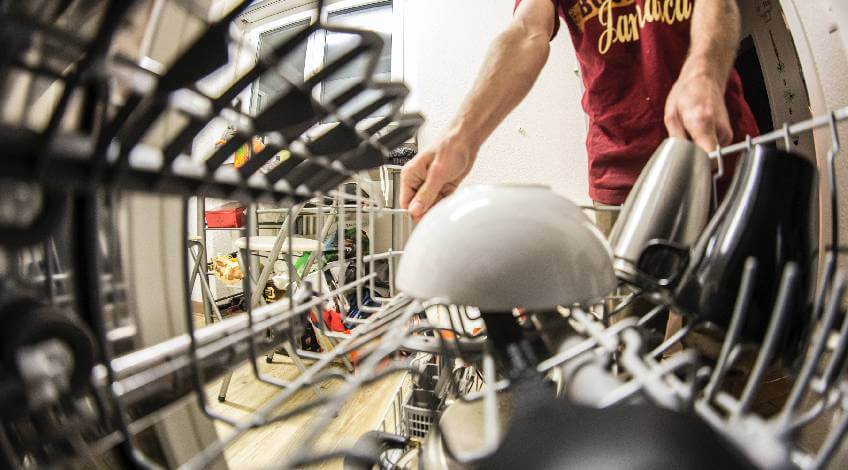
In many cases the dishes are getting dried in the dishwasher but there is still residual water on the upper rack. This then drops onto the dishes on the lower rack as the upper rack is emptied.
Which is why you should always unload the lower rack first. This prevents any water from dripping onto the dry items on the lower rack.
Drying Plastic Dishes

Stainless steel, glassware and ceramics absorb heat which is used in the drying process. Plastic items are unable to retain heat in the same way which is why plastic items are often left feeling wet after the dishwasher’s drying cycle has completed.
You should wash plastic items separately to avoid this from being a problem.
No Rinse Aid
When we think of rinse aid, we think of shiny dishes. It is true that rinse aid helps dishes to sparkle, but it also helps in the drying process. Rinse aid alters the structure of the water droplets allowing them to run off glassware and ceramics easier.
The extra water that runs off these items reduces the amount of water left to dry which helps get them dry properly. You should always ensure the rinse aid dispenser is regularly topped up and not allowed to run out.
Using Too Much Or An Incorrect Detergent
If you use a low grade detergent in your dishwasher it can leave a residue on the dishes which can prevent proper drying. The same is true if you use the correct type of detergent in too large a quantity.
You should always ensure that you are using the correct type and amount of detergent to suit the load you are washing.
Not Opening The Dishwasher Door
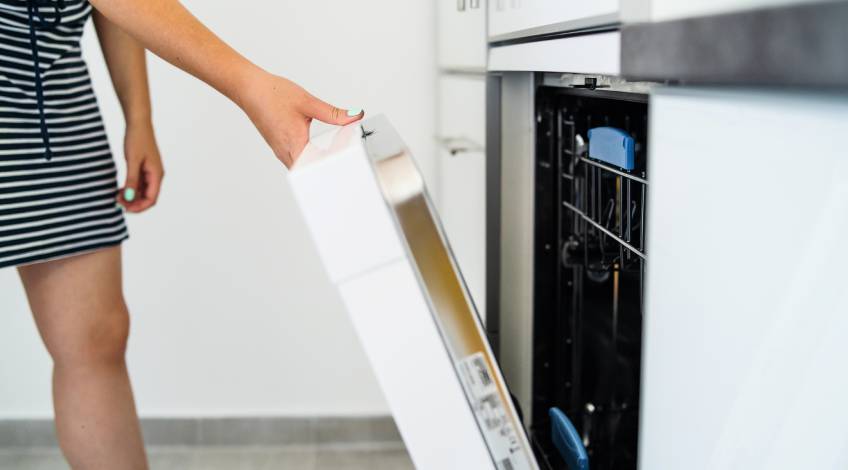
As soon as the cycle finishes, you should open the dishwasher door slightly to allow hot, moist air to escape. This prevents it from forming water droplets inside the dishwasher that can drip onto the dry dishes.
Consult your user manual to see if this applies to your particular model.
Defective Thermostat
The thermostat controls the level of heat for the water used to wash your dishes and the air used to dry them. If the thermostat develops a fault, it could mean the dishes don’t get any hot air to dry them.
We recommend getting a technician to investigate and replace the thermostat if necessary.
Defective Heating Element
Dishwashers have a heating element that heats up the water to wash the dishes and heats up the air to dry them too. If the heating element is defective it will not produce any hot air and the dishes will not dry.
If you suspect the heating element is faulty, we recommend contacting a technician to investigate and replace it for you.
Faulty Aquaflex Function
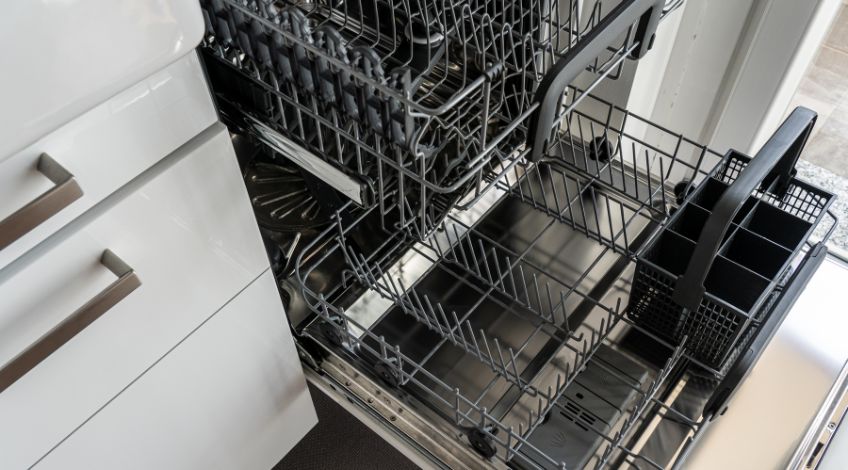
Some Beko dishwashers have Aquaflex technology which is designed to handle mixed loads and enhance the washing and drying functions. If, after using the Aquaflex option, your dishes are still wet, it could be that the Aquaflex isn’t working correctly.
You will need to check if the Aquaflex is working correctly and if not contact a technician to investigate further.
Control Board Malfunction
All of the functions on your dishwasher are controlled by the control board. If it malfunctions, it can cause the dishwasher to fail to dry the dishes.
In some cases this can be cleared by resetting the dishwasher. This can be done by disconnecting the power supply for 10 to 15 minutes to allow any residual power to dissipate. When the appliance is reconnected to the power supply, the problem has cleared and the dishwasher will function as normal again.
However, this is not always the case and it could prove to be the control board that is malfunctioning. We recommend getting a technician to investigate and replace the control board for you as it is a delicate and expensive part.
Ways To Prevent This From Happening Again
Once you have solved the issue of your Beko dishwasher not drying, you can help prevent it from happening again by sticking to the following;
- Always select the correct cycle
- Ensure you have selected a cycle with drying
- Ensure your dishes are loaded into the racks correctly
- Always unload the dishes from the lower rack first
- Ensure that you use the correct type and quantity of detergent
- Ensure the rinse aid dispenser is topped up
- Always wash plastic items separately
SEE ALSO: Reasons Why Some Dishwasher Don’t Properly Dry Dishes
Frequently Asked Questions
If your Beko dishwasher isn’t drying the dishes it could be because; you have incorrectly loaded the racks, you have used too much or the incorrect type of detergent, the rinse aid dispenser needs topping up, the thermostat is defective, the heating element is defective, the Aquaflex function isn’t working properly, or the control board has malfunctioned.
Beko dishwashers do have a drying cycle which on some models is set automatically by the inboard sensors.
Some dishwashers benefit from having the door opened as soon as the cycle ends to allow hot moist air to escape and improve the drying of the dishes.
Also, follow us on Pinterest ...



